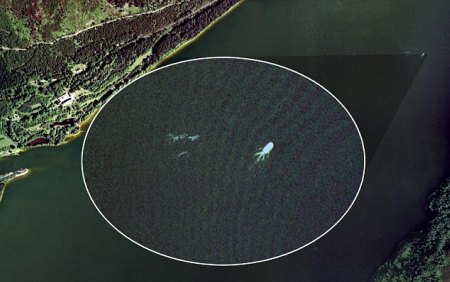Loch Ness Monster sighted on Google Earth
An image of the fabled Nessie in Scotland's Loch Ness has been seen from space on Google Earth


Security guard James Cooke claims to have seen the fabled Loch Ness Monster while browsing on Google Earth.
Mr Cooke, who lives in Nottingham, was struck by a satellite photograph that shows a 65ft object resembling a sea creature just beneath the surface of the water.
Mr Cooke said: ‘I couldn't believe it. It's just like the descriptions of Nessie.'

Adrian Shine, a researcher for the Loch Ness Project, commented: ‘This is really intriguing. It needs further study.'
The Loch Ness Monster first came to the world's attention in 1993. Some ‘Nessie' enthusiasts believe the creature is a plesiosaur, an aquatic reptile that appeared at the start of the Jurassic period, and claimed that a series of vertebrae uncovered on the shores of Loch Ness were proof that there was a living plesiosaur in the Loch.
There was an underwater search for the creature in 2008, in which scientists used sonar and special cameras. However, earlier this year, it was reported that climate change may have killed the creature, and veteran monster-hunter Dr Robert Rines announced that the environmental conditions would no longer sustain it.
To study the Google Earth image, enter coordinates Latitude 57°12'52.13"N, Longitude 4°34'14.16"W.
Sign up for the Country Life Newsletter
Exquisite houses, the beauty of Nature, and how to get the most from your life, straight to your inbox.
To comment on this article, use the comment box below, or email us at clonews@ipcmedia.com. Read more about the countryside
For more news stories like this every week subscribe and save
Country Life is unlike any other magazine: the only glossy weekly on the newsstand and the only magazine that has been guest-edited by HRH The King not once, but twice. It is a celebration of modern rural life and all its diverse joys and pleasures — that was first published in Queen Victoria's Diamond Jubilee year. Our eclectic mixture of witty and informative content — from the most up-to-date property news and commentary and a coveted glimpse inside some of the UK's best houses and gardens, to gardening, the arts and interior design, written by experts in their field — still cannot be found in print or online, anywhere else.
-
 A rare opportunity to own a family home on Vanbrugh Terrace, one of London's finest streets
A rare opportunity to own a family home on Vanbrugh Terrace, one of London's finest streetsThis six-bedroom Victorian home sits right on the start line of the London Marathon, with easy access to Blackheath and Greenwich Park.
By James Fisher
-
 Materials, textures, construction, expression: A Brutalist watch on your wrist
Materials, textures, construction, expression: A Brutalist watch on your wristLuxury watchmakers are seeking to bridge the gap between two contrasting styles, with exciting results.
By Chris Hall